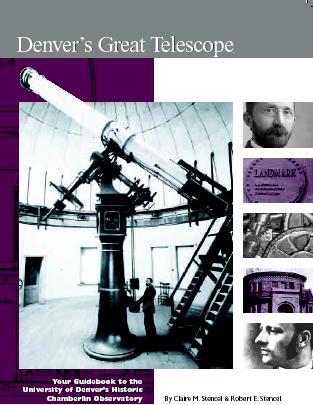
Join the Friends of Chamberlin Observatory
Send an email to rstencel at du.edu with contact info.
A student recently asked how the study of astronomy helps the
nation. Astronomy inspires and challenges. Since ancient times, people
have learned to use the stars for time and calendar keeping. Movements of
the planets inspired theories of gravitation, which helped promote physics
and engineering, and continue to offer extreme tests for both -
relativity/cosmology and spaceflight. Finally, astronomy gives us "the
biggest picture" of the universe and our place in it, and provides lessons
about why we should take better care of this special planet we depend
upon, starting with keeping an eye out for hazardous asteroids and finding
cures for energy-wasting light pollution.
In light of the foregoing, what now are the possible roles and futures for
the University of Denver's historic Chamberlin Observatory and its antique
telescope? Three overlapping roles include research, teaching and
outreach - the trinity for university faculty and academic facilities most
everywhere. In October 1993, Prof. Stencel organized a "Chamberlin
Centennial Re-dedication" event to officially breathe new life into the
old observatory, and to set the stage for renewed recovery efforts. In
those days, the University of Denver was busy with larger issues of
financial recovery from a recent recession. Thus he needed to organize
funds, volunteers and contracts for work at Chamberlin. Immediate needs,
like the failing balcony and bathroom flooring were addressed with small
contracts to local carpenters. Fortune had it that DU's Risk Manager,
Janet Parnell's husband, James, was also a restoration engineer at CSU
(Colorado State University), who advised on proper methods for re-pointing
a great deal of failing mortar in the pier basement interior walls. Keith
Heaton of Physical Plant recommended the help of a delightful "old
school" German mason to tuck-point all the exterior mortar, on
contract. The high point in this period was reached on Aug. 1, 1994 -
close to the hundredth anniversary day of the telescope's first light,
when the Denver City Council unanimously approved the resolution naming
Chamberlin Observatory as a Denver Landmark, giving it real legal
protections from demolition. Susan Conat-Stencel deserves the full credit
for writing and assembling the Landmark application and guiding it through
the review processes.
As of this writing, in addition to programmatic needs, there are many
infrastructure needs to attend to as well. Thanks to the perseverance of
those directly associated with the drive to sustain the astronomical
tradition Chamberlin Observatory represents, there exists several proposed
goals for the coming years regarding its survival: (a) restore the
Clark-Saegmuller refractor to its historically accurate condition, and
continue public outreach programs with staff and volunteer
collaboration; (b) address code and ADA problems with the building, per
the preservation master plan - developed as part of a building
preservation grant from State Historical Society; (c) recapture the
research and training component for which Chamberlin was intended, but has
lost due to antiquated equipment and infrastructure. The most important
facet of the Chamberlin Observatory is that it continues to be a magnet
that enables students and the public to view astronomical objects, and not
be merely an architectural mausoleum. Although it appears that Chamberlin
Observatory has muddled along with volunteer help and occasional emergency
repairs, it awaits the interest and energy of an organization willing to
invest in a level of staffing and budget never before
realized. By sustaining Chamberlin Observatory, we will inspire new
students and fulfill Howe's vision "to encourage the habit of accurate
observation; to strengthen reasoning by the application of mathematics to
astronomical phenomena, and its pure disciplinary value - lifting the mind
from daily cares, to the contemplation of awe-inspiring grandeur."
Uncontrolled lighting practises
As electric lights became more affordable, and housing density grew around
the observatory, the issues of glare, light trespass and sky glow have
become a problem for observing. Poorly aimed lights and excessive levels
of lighting, such as those found around commercially zoned districts,
cumulatively create light pollution. The lights create a sky glow, which
makes it difficult to see fainter stars in the night sky, and represent a
substantial amount of energy waste, going upwards into the sky -
illuminating clouds and birds. Visibility of the Milky Way vanished from
Denver a couple of decades ago, and the ability to see all but the
brightest stars is a challenge to most observatory visitors and
students. This is a widespread problem for observers, because there are
fewer and fewer places where there are no electric lights. The area
around Chamberlin was once a perfect spot to observe the night sky, free
from the glow of electric lights. Over the years, Observatory Park has
been under assault by more and more lighting, making observing
increasingly difficult.
Astronomers recognized the growing problem as early as 1980 and formed the
International Dark Sky Association [www.darksky.org]. In Colorado,
campaigns to modify building codes to deal with glare, light trespass and
skyglow problems have been underway for several years at local, county and
statewide levels. Artificial light is a form of radiation that we must
learn to use wisely, not merely because of the energy and environmental
costs, but for human health reasons: increasingly the link between
disruption of nocturnal melatonin production [a brain hormone] and stress,
eyesight problems and cancer is being recognized. For those with problem
lights from a neighbor: talk with the person about adding some shielding,
to shade your direction, or replacing the light with one of many energy
efficient, directable lamps now available in hardware stores. Members of
the Colorado section of the Dark Sky Association also are available to
help with your questions, email coloida at hotmail.com .
More to follow... 080323
 HOME PAGE
HOME PAGE

 HOME PAGE
HOME PAGE